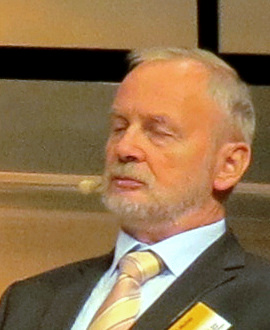Hartmut Michel facts for kids
Quick facts for kids
Hartmut Michel
|
|
|---|---|

Hartmut Michel in 2013
|
|
| Born | 18 July 1948 Ludwigsburg, Württemberg-Baden, American Zone, Allied-occupied Germany
(now in Baden-Württemberg, Germany) |
| Nationality | German |
| Alma mater | University of Tübingen |
| Known for | Crystallisation of membrane proteins |
| Spouse(s) | Elena Olkhova |
| Awards |
|
| Scientific career | |
| Fields | Biochemistry |
| Institutions | Max Planck Institute for Biophysics |
Hartmut Michel (born 18 July 1948) is a German biochemist. He won the Nobel Prize in Chemistry in 1988. He received this award for figuring out the exact structure of a special protein. This protein is found in cell membranes and is very important for photosynthesis.
Contents
Early Life and Education
Hartmut Michel was born in Ludwigsburg, Germany, on July 18, 1948. After serving in the military, he went to the University of Tübingen. There, he studied biochemistry, which is the study of chemical processes in living things. For his final year, he worked in a lab studying how certain bacteria use energy.
Discovering Protein Structures
Hartmut Michel later focused on studying membrane proteins. These proteins are found in the outer layers of cells. To understand how they work, scientists need to know their exact shape. Michel worked on a method called X-ray crystallography. This method uses X-rays to create a 3D picture of tiny structures like proteins.
The Nobel Prize Discovery
In 1988, Hartmut Michel shared the Nobel Prize with two other scientists, Johann Deisenhofer and Robert Huber. They worked together to find the 3D structure of a protein complex. This complex is found in certain bacteria that perform a simple type of photosynthesis.
This special protein complex is called a photosynthetic reaction center. It plays a key role in starting photosynthesis. Between 1982 and 1985, the three scientists used X-ray crystallography. They figured out the exact arrangement of more than 10,000 atoms in this protein complex.
Their research helped scientists better understand how photosynthesis works. It also showed that photosynthesis in plants and bacteria has similar steps. Their work also created a new way to study membrane proteins.
Current Work
Since 1987, Hartmut Michel has been a director at the Max Planck Institute for Biophysics. This institute is in Frankfurt am Main, Germany. He is also a professor of biochemistry at the Goethe University Frankfurt.
Awards and Recognition
Hartmut Michel has received many important awards for his scientific work.
- In 1986, he received the Gottfried Wilhelm Leibniz Prize. This is the highest honor for research in Germany.
- In 1988, he was awarded the Nobel Prize in Chemistry.
- In 1989, he received the Bijvoet Medal from Utrecht University.
- He became a member of the German Academy of Sciences Leopoldina in 1995.
- Also in 1995, he became a foreign member of the Royal Netherlands Academy of Arts and Sciences.
- In 2005, he was chosen as a Foreign Member of the Royal Society, a famous scientific group in the UK.
See also
 In Spanish: Hartmut Michel para niños
In Spanish: Hartmut Michel para niños

